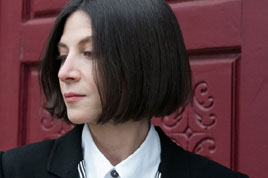Entertaining 'Little Friend' a smart story of innocence lost
by Earl L. Dachslager The Houston Chronicle, November 1, 2002
Donna Tartt's first novel, The Secret History, published when its author was just 28 years old, turned out to be a huge hit -- translated into 23 languages, three-months on the best-seller list and still in print. Now, after a 10-year intermission, Tartt's eagerly awaited second novel has appeared, and it looks like another winner.Fans of Tartt's first novel, among whom I include myself, will definitely find much to admire in The Little Friend, even though the two books are very different.
While The Little Friend recaps some of the same themes and events that made The Secret History so compelling -- innocence versus experience, a senseless and mysterious death, a mainly sexless world, and a dark and decadent society -- it also departs from Tartt's first book in telling ways, most notably in its setting and its cast of characters. Overall, Tartt's new novel is denser, more multilayered, than her first. More mature, one could say, and thus a bit heavier and slower, but for all that no less enjoyable or readable.
Whereas The Secret History was set in a small New England liberal arts college based on Tartt's alma mater (Bennington College in Vermont), her new book is set in the fictional town of Alexandria, Miss., presumably modeled after Tartt's own hometown of Greenwood, where she was born in 1963.
In The Secret History the leading cast of characters was a clique of spoiled and cynical college students, mostly male; in The Little Friend just about all of the main characters, with the exception of the bad guys, are female, including the novel's protagonist and heroine, 12-year-old Harriet Cleve Dufresnes.
The novel opens with a brief prologue in which we are told of the brutal killing of Harriet's 9-year-old brother, Robin, who was discovered, on Mother's Day, hanging from a tree in the back yard of the family home, a cluttered, messy house "with garbage and trash all over the place" where Harriet lives with her mother, Charlotte, and older sister Allison.
The story then jumps ahead 12 years to the mid-1970s, with Robin's brutal death still unsolved. "Twelve years after Robin Cleve's death no one knew any more about how he had ended up hanged from a tree in his own yard than they had on the day it happened," Tartt tells us at the story's outset.
The aftermath of Robin's death -- its devastating and pervasive effects on Robin's family -- are what Tartt's book is about: how one horrible, cruel moment can urge an entire family to the edge of ruin and, in some cases, over the edge.
The event has left Charlotte permanently depressed and distracted, a lost soul tormented by feelings of guilt. (The fact that her son's death occurred on Mother's Day only exacerbates her despair.) Robin's grandmother Edie, while putting on a brave show for the family, has also been profoundly affected. "Grief," Tartt curtly states, "had turned her into stone."
Harriet's father, Dix, as a result of the overbearing gloom that pervaded his world following the killing of his young son, abandons his family "for a wood-paneled office and jazzy social life in Nashville," where he lives with his girlfriend. And Allison, now nearly 17 and "slightly unhinged," finds escape from her squalid surroundings and the torments of her brother's death in the refuge of sleep and the attentions of her boyfriend.
But Harriet, the book's plucky, strong-willed and inquisitive heroine, is the family member most profoundly affected and most determined to discover how and why her brother died.
For Harriet, Robin's death remains utterly senseless, a meaningless, incomprehensible event. If Lazarus and Jesus could rise from the dead, why then, she ponders, couldn't her brother? More than anything, what Harriet longs for is "to have her brother back. Next to that she wanted to find out who killed him."
It is surely not by accident that Harriet's favorite literary characters happen to be explorer Robert Scott, Sherlock Holmes and Nancy Drew and her favorite books Treasure Island, Oliver Twist and The Jungle Books, tales that in more ways than one turn out to be the stuff of her own life.
The villains of the novel, and Harriet's collective nemesis, are the trashy Ratliff brothers -- racists, ex-convicts, itinerant preachers, drug dealers, all-around losers -- who live on the other side of the river in a cramped, broken-down trailer with their aged grandmother, "a tiny, emaciated, leather-brown creature, stooped from continual cringing," whom they refer to as Gum.
It is this band of brothers, feral and dangerous, with whom Harriet comes in conflict in her obsessive and at times reckless search for her brother's killer. Think Nancy Drew meets Flannery O'Connor.
In her quest Harriet is aided by her classmate and admirer Hely Hull, one of the few virtuous males in the story. But even Hely, who is given to reading lurid comic books and fantasizing about being a superhero, eventually abandons the quest, leaving Harriet to accomplish her goal on her own.
Harriet inevitably runs into unanticipated and unpleasant barriers: the death of one of her great aunts; the absence of Ida Rhew, Charlotte's exploited "colored" maid and Harriet's surrogate mother; and most of all the recognition that life is way more complex, mysterious and unpredictable than she -- smart as she is -- ever could have imagined.
Some of Harriet's more outlandish adventures, such as her do-or-die battle atop a water tower with Danny Ratliff, come across as stagey and formulaic, almost as if deliberately written for an action movie. But for the most part Harriet's escapades are credible and compelling, guaranteed to keep the reader turning the pages way past bedtime.
To take one example, her and Hely's mad entanglement with a couple of scary hill-country snake handlers in a house of horrors filled with crates of venomous snakes is as freaky and funny as it is frightening.
Harriet's forced excursion to a hated summer camp in rural Mississippi, outwardly all jovial and playful, inwardly sinister and demeaning, is perfectly rendered and deadly accurate, one of the best scenes in the book. "During these discussions [personal hygiene], Harriet burned radiant with hatred and shame. She felt degraded by Nursie's blithe assumptions that she -- Harriet -- was no different from these stupid Tupelo girls: preoccupied with under-arm odor, the reproductive system, and dating."
As demonstrated by her first novel and confirmed by this one, Tartt is a superb storyteller, an obviously gifted writer in full command of her considerable verbal talents. Stylistically, Tartt is partial to the use of colons and semicolons, a trait that makes her writing formal, balanced and precise. "Daylight flooded in through the broken roof; the dark tank glowed a lush, emerald green: the green of swamps and jungles, of Mowgli's abandoned cities."
Tartt's phrasing often has a slightly old-fashioned quality about it, in keeping perhaps with the book's generally decadent atmosphere. And her diction at times can be downright highfalutin' ("fabular," "alcazar," ""tatterdemalion," "ormolu," "cumbrous").
She can spin off sentences that rub elbows with poetry ("Raindrops leaped like little silver fish on the surface of the water") and sentences descriptive of urban decay ("The Interstate had passed Alexandria by; and now the highway suffered the same dereliction as the shops on the square: defunct grocery stores and car lots, baking in a poisonous gray heat haze; the Checkerboard Feed Store and the old Southland gas station, boarded up now ... ").
Occasionally, she'll try for an effect that doesn't quite succeed or that comes across as overblown and strained. But such misfires are rare. For the most part Tartt's writing is sharp and carefully honed, literate without being (in the worse sense) literary.
In all respects -- style, setting, characters, plot -- The Little Friend is a smartly written, greatly entertaining novel: part mystery story, part Southern cultural history, part family saga, part tale of good and evil, but most of all a story of a young girl's initiation into a fallen and corrupted world.
Earl L. Dachslager is professor emeritus of English at the University of Houston.
+ + + Comments + + +



